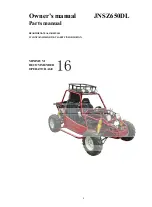
143
PC256
1. Verify the oil level is below the float; then remove
the sensor from the oil reservoir by twisting and pull-
ing out. Wipe excess oil from the sensor.
2. Unplug the sensor from the wiring harness.
3. Set the meter selector to the OHMS position.
4. Touch each of the meter leads to one of the terminals
on the sensor. With the sensor in its normal position
(float end down), the meter should read less than 1
ohm.
5. If the meter reads greater than 1 ohm, check to make
sure good contact has been made with each of the
terminals on the sensor. If the meter still reads
greater than 1 ohm, replace the sensor.
6. While maintaining contact between the meter leads
and the sensor, raise the float. The meter must read
OL (infinite resistance). If the meter reads less than 1
ohm, replace the sensor.
7. If the sensor tests satisfactory but the icon doesn’t
illuminate with only a small amount of oil in the res-
ervoir, verify the icon illuminates on start-up.
Testing Fuel Gauge Sender
NOTE: Before testing the sender, verify the harness
from the sender to the gauge is satisfactory.
1. Remove the hood.
2. Disconnect the fuel gauge sender unit from the main
wiring harness; then connect the ohmmeter leads to
the two blue sender wires.
3. Compare the reading to the chart following.
Emergency Stop Switch
RESISTANCE
1. Remove the four torx-head cap screws securing the
front/rear throttle control housing assembly to the
handlebar.
2. Set the selector to the OHMS position.
3. Connect one tester lead to one pin; then connect the
other tester lead to the other pin.
PC253A
4. With the switch in the OFF position, the meter must
read less than 1 ohm resistance.
5. With the switch in the RUN position, the meter must
read OL (infinite resistance).
NOTE: If the meter does not show as specified, trou-
bleshoot or replace the switch/component, the connec-
tor, or the switch wiring harness.
Starter Relay Solenoid
TESTING
NOTE: The electric start solenoid may be tested
using either one of the following methods.
Method #1
1. Disconnect the solenoid connector from the main
wiring harness.
2. Place the ohmmeter leads across the solenoid coil
terminals. The ohmmeter must read 3-5 ohms.
NOTE: An in-line ammeter would measure between
2 and 4 amps of solenoid coil current flow with the
battery connected.
Method #2
1. Using the multimeter set to the DC Voltage position,
check the relay as follows.
2. Connect the red tester lead to the positive battery ter-
minal; then connect the black tester lead to the starter
cable connection on the starter relay. The meter must
show battery voltage.
NOTE: Engage the brake lever lock and place the
emergency stop switch in the RUN position.
3. Engage the starter while observing the multimeter.
The multimeter should drop to 0 volts and a “click”
should be heard from the relay.
Full <20
ohms
1/2
40-56 ohms
Empty
76-105 ohms
CAUTION
NEVER connect an in-line ammeter with the large
starter cables because the 200 amps of current flow will
instantly damage most ammeters.
Summary of Contents for M 8000
Page 1: ...www arcticcat com SERVICE MANUAL www arcticcat com...
Page 42: ...41 500cc_2A_15...
Page 50: ...49 600_14_2...
Page 58: ...57 800_12_2...
Page 155: ...154 Troubleshooting Servomotor SERVO1A16...
Page 156: ...155 SERVO2rv16...
Page 193: ...192 0747 414 M 141 High Country Models...
Page 209: ...208 NOTES...
Page 210: ...Printed in U S A Trademarks of Arctic Cat Inc Thief River Falls MN 56701 p n 2260 847...
















































